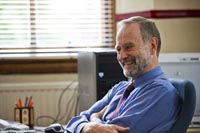Glasgow scientists honoured by IEEE
Published: 7 February 2011
The Institute of Electrical and Electronic Engineering have awarded Profs John Chapman and Asen Asenov fellowship of the organisation
 Professor John Chapman, Head of the College of Science and Engineering, and Professor Asen Asenov, James Watt Chair in Electrical Engineering at the University, have both recently been awarded Fellowship of the very prestigious Institute of Electrical and Electronics Engineers (IEEE).
Professor John Chapman, Head of the College of Science and Engineering, and Professor Asen Asenov, James Watt Chair in Electrical Engineering at the University, have both recently been awarded Fellowship of the very prestigious Institute of Electrical and Electronics Engineers (IEEE).
The Fellowship was awarded to Prof Chapman’s in recognition of his “contributions to the measurement of magnetization processes in thin films and nanostructures,” while the Institute recognized Prof Asenov’s “contributions to the understanding and prediction of semiconductor device variability via modeling and simulation.”
Professor Asenov, Leader of the Glasgow Device Modeling Group, is the undisputed authority in the area of statistical CMOS variability. His fundamental sole authored paper A. Asenov, Random dopant induced threshold voltage lowering and fluctuations in sub 0.1 micron MOSFETs: A 3D ‘atomistic’ simulation study, IEEE Trans. Electron Dev., Vol. 45, No. 12 (1998).45, No. 12 (1998) has been cited more than 250 times.
Since then he has published more than 300 papers in the area of statistical variability and given more than 160 invited talks on this subject, introducing a string of new subjects to the field
Recently Professor Asenov founded Gold Standard Simulations Ltd, a company based on the wealth of knowledge and software tools developed by him and his team over the last 15 years. The company, which Professor Asenov is CEO and Director of, recently won the prestigious 2010 award of the National Microelectronic Institute (NMI) for R&D Achievements.
Speaking about the award, Professor Asenov said: “The IEEE is the world’s largest and more influential professional organization for the advancement of technology. For me this is award marks my life-long achievements in a career devoted to the advancement of the semiconductor modeling and simulation.”
Prof Chapman said: “I have worked in my research area for quite a number of years, pioneering new ways of visualising the magnetisation distribution in magnetic nanostructures. Particularly exciting for me has been the move from being able to study a single magnetic state to the position we now occupy whereby we can change the magnetic state in situ in the microscope we use for imaging.
“This advance has transformed the impact of our work allowing us to play a major role in the optimisation of the performance of magnetic sensors and storage devices.
“We have contributed to the dramatic improvements in storage capacity in computers, hand held devices and home entertainment systems. Indeed, information storage densities have increased by a factor of 500,000 over the last two decades and the ability to image directly how the magnetisation changes as devices are miniaturised has played a crucial role.”
First published: 7 February 2011
<< Feb

